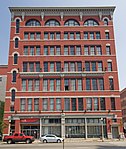Taft Theatre

The Taft Theatre is a 2,500-seat theater, located in Cincinnati, Ohio. The theatre was built in 1928, as evidenced by its Art Deco interior. All seats are unobstructed, giving every seat a clear view of the stage. It is part of the Masonic Temple Building at Fifth and Sycamore streets. It is home to The Children Theatre of Cincinnati. As of 2010, it is operated by Music & Event Management Inc., a subsidiary of Cincinnati Symphony Orchestra. Music & Event Management Inc. also operates Riverbend Music Center and PNC Pavilion. The theatre underwent $3 million worth of upgrades and renovations for air conditioning, seating, restroom improvements and other amenities.It is used for Broadway shows, concerts, comedy and other special events. The theatre played host to the politically motivated Vote for Change Tour on October 2, 2004, featuring performances by Keb' Mo', Bonnie Raitt and Jackson Browne.
Excerpt from the Wikipedia article Taft Theatre (License: CC BY-SA 3.0, Authors, Images).Taft Theatre
Sycamore Street, Cincinnati Central Business District
Geographical coordinates (GPS) Address External links Nearby Places Show on map
Geographical coordinates (GPS)
| Latitude | Longitude |
|---|---|
| N 39.101729 ° | E -84.507732 ° |
Address
Taft Theatre (Taft Auditorium)
Sycamore Street
45202 Cincinnati, Central Business District
Ohio, United States
Open on Google Maps









